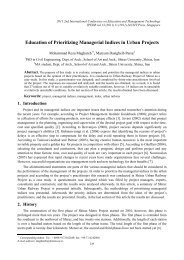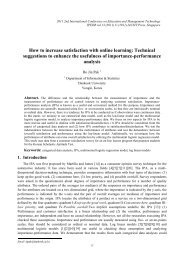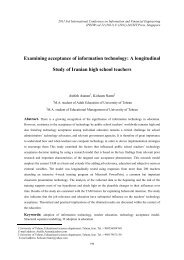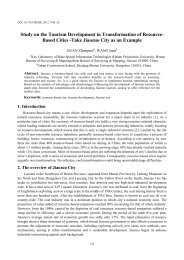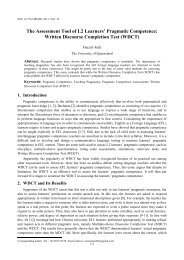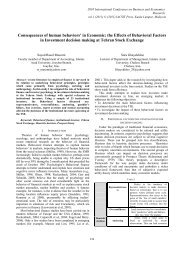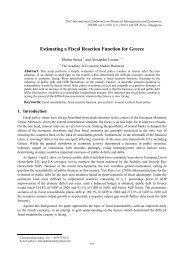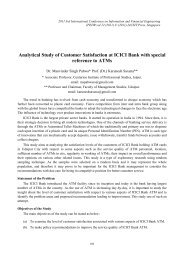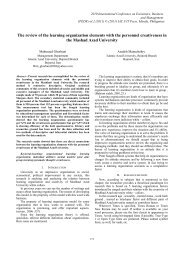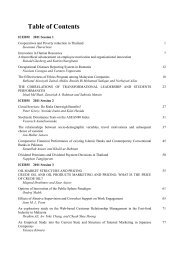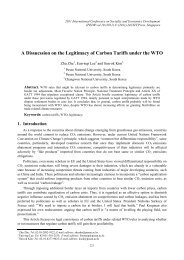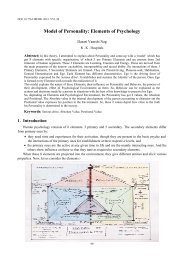Transformation of analysis model to design model - ResearchGate
Transformation of analysis model to design model - ResearchGate
Transformation of analysis model to design model - ResearchGate
Create successful ePaper yourself
Turn your PDF publications into a flip-book with our unique Google optimized e-Paper software.
Warnier-Orr [11] diagram can also be used. During<br />
detailed <strong>design</strong>, the data structure and the algorithms <strong>of</strong> the<br />
different modules are <strong>design</strong>ed.<br />
Implementation<br />
Environment<br />
(Language)<br />
Presentation<br />
Behavior<br />
Information<br />
Figure 2. A Design <strong>model</strong> with a new dimension.<br />
A. Design Model<br />
The <strong>analysis</strong> <strong>model</strong> is refined and formalized <strong>to</strong> get a<br />
<strong>design</strong> <strong>model</strong>. During <strong>design</strong> <strong>model</strong>ing, we try <strong>to</strong> adapt <strong>to</strong><br />
the actual implementation environment. In <strong>design</strong> space, yet<br />
another new dimension has been added <strong>to</strong> the <strong>analysis</strong> space<br />
<strong>to</strong> include the implementation environment. This is show in<br />
fig. 2. This means that we want <strong>to</strong> adopt our <strong>analysis</strong> <strong>model</strong><br />
<strong>to</strong> fit in the implementation <strong>model</strong> at the same time as we<br />
refine it. But changes cannot be avoided so, we develop a<br />
new <strong>model</strong>.<br />
III.<br />
METHOD<br />
S<strong>of</strong>tware <strong>design</strong> sits at the technical kernel <strong>of</strong> s<strong>of</strong>tware<br />
engineering and is applied regardless <strong>of</strong> the s<strong>of</strong>tware<br />
process <strong>model</strong> that is used [9]. Beginning once s<strong>of</strong>tware<br />
requirements have been analyzed and specified, s<strong>of</strong>tware<br />
<strong>design</strong> is the first <strong>of</strong> three technical activities—<strong>design</strong>, code<br />
generation, and test—that are required <strong>to</strong> build and verify<br />
the s<strong>of</strong>tware. Each activity transforms information in a<br />
manner that ultimately results in validated computer<br />
s<strong>of</strong>tware. Each <strong>of</strong> the elements <strong>of</strong> the <strong>analysis</strong> <strong>model</strong><br />
provides information that is necessary <strong>to</strong> create the four<br />
<strong>design</strong> <strong>model</strong>s required for a complete specification <strong>of</strong><br />
<strong>design</strong>. The flow <strong>of</strong> information during s<strong>of</strong>tware <strong>design</strong> is<br />
illustrated in Figure 3. S<strong>of</strong>tware requirements, manifested<br />
by the data, functional, and behavioral <strong>model</strong>s, feed the<br />
<strong>design</strong> task. Using one the <strong>design</strong> methods. The <strong>design</strong> task<br />
produces a data <strong>design</strong>, an architectural <strong>design</strong>, an interface<br />
<strong>design</strong>, and a component <strong>design</strong> [6]. The data <strong>design</strong><br />
transforms the information domain <strong>model</strong> created during<br />
<strong>analysis</strong> in<strong>to</strong> the data structures that will be required <strong>to</strong><br />
implement the s<strong>of</strong>tware.<br />
The data objects and relationships defined in the entity<br />
relationship diagram and the detailed data content depicted<br />
in the data dictionary provide the basis for the data <strong>design</strong><br />
activity [6]. Part <strong>of</strong> data <strong>design</strong> may occur in conjunction<br />
with the <strong>design</strong> <strong>of</strong> s<strong>of</strong>tware architecture. More detailed data<br />
<strong>design</strong> occurs as each s<strong>of</strong>tware component is <strong>design</strong>ed.<br />
The architectural <strong>design</strong> defines the relationship between<br />
major structural elements <strong>of</strong> the s<strong>of</strong>tware, the ―<strong>design</strong><br />
patterns‖ that can be used <strong>to</strong> achieve the requirements that<br />
have been defined for the system, and the constraints that<br />
affect the way in which architectural <strong>design</strong> patterns can be<br />
applied [8]. The architectural <strong>design</strong> representation—the<br />
framework <strong>of</strong> a computer-based system—can be derived<br />
from the system specification, the <strong>analysis</strong> <strong>model</strong>, and the<br />
interaction <strong>of</strong> subsystems defined within the <strong>analysis</strong> <strong>model</strong>.<br />
The interface <strong>design</strong> describes how the s<strong>of</strong>tware<br />
communicates within itself, with systems that interoperate<br />
with it, and with humans who use it. An interface implies a<br />
flow <strong>of</strong> information (e.g., data and/or control) and a specific<br />
type <strong>of</strong> behavior. Therefore, data and control flow diagrams<br />
provide much <strong>of</strong> the information required for interface<br />
<strong>design</strong>.<br />
The importance <strong>of</strong> s<strong>of</strong>tware <strong>design</strong> can be stated with a<br />
single word—quality [9]. Design is the place where quality<br />
is fostered in s<strong>of</strong>tware engineering. Design provides us with<br />
representations <strong>of</strong> s<strong>of</strong>tware that can be assessed for quality.<br />
Design is the only way that we can accurately translate a<br />
cus<strong>to</strong>mer's requirements in<strong>to</strong> a quality s<strong>of</strong>tware product or<br />
system. S<strong>of</strong>tware <strong>design</strong> serves as the foundation for all the<br />
s<strong>of</strong>tware engineering and s<strong>of</strong>tware support steps that follow.<br />
Without <strong>design</strong>, we risk building an unstable system—one<br />
that will fail when small changes are made; one that may be<br />
difficult <strong>to</strong> test; one whose quality cannot be assessed until<br />
late in the s<strong>of</strong>tware process, when time is short and many<br />
dollars have already been spent. Explaining the idea/concept<br />
<strong>of</strong> something usually with graphical diagrams with the<br />
intention <strong>to</strong> build from the explanation. The <strong>design</strong> is a<br />
representation <strong>of</strong> a product or a system with sufficient detail<br />
for implementation. From our understanding <strong>of</strong> the problem,<br />
we start building the s<strong>of</strong>tware. Translate the <strong>analysis</strong> <strong>model</strong><br />
in<strong>to</strong> the <strong>design</strong> <strong>model</strong>. Map the information from the<br />
<strong>analysis</strong> <strong>model</strong> <strong>to</strong> the <strong>design</strong> representations - data <strong>design</strong>,<br />
architectural <strong>design</strong>, interface <strong>design</strong>, procedural <strong>design</strong>.<br />
A. The <strong>design</strong> process should not suffer from tunnel vision<br />
A good <strong>design</strong>er should consider alternative approaches,<br />
judging each based on the requirements <strong>of</strong> the problem, the<br />
resources available <strong>to</strong> do the job [11].<br />
B. The <strong>design</strong> should be traceable <strong>to</strong> the <strong>analysis</strong> <strong>model</strong><br />
Because a single element <strong>of</strong> the <strong>design</strong> <strong>model</strong> <strong>of</strong>ten<br />
traces <strong>to</strong> multiple requirements, it is necessary <strong>to</strong> have a<br />
means for tracking how requirements have been satisfied by<br />
the <strong>design</strong> <strong>model</strong>.<br />
C. The <strong>design</strong> should minimize the intellectual distance<br />
between the s<strong>of</strong>tware and the problem as it exists in the<br />
real world.<br />
That is, the structure <strong>of</strong> the s<strong>of</strong>tware <strong>design</strong> should<br />
(whenever possible) mimic the structure <strong>of</strong> the problem<br />
domain.<br />
214



